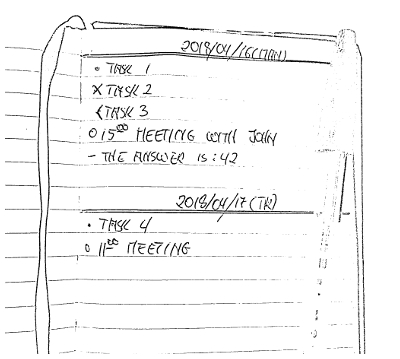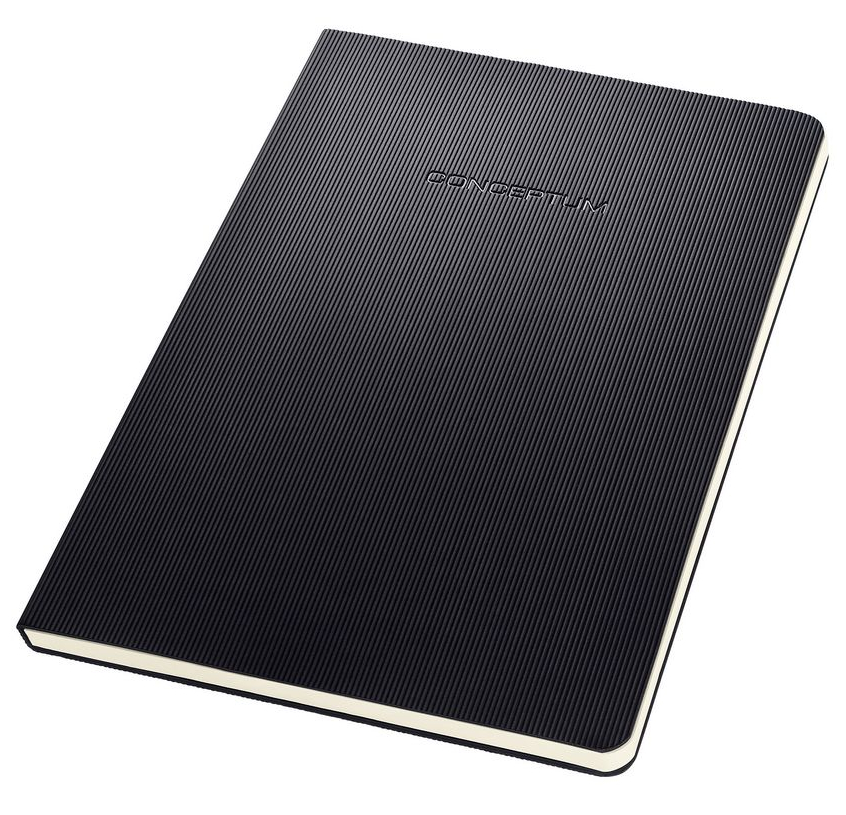See also
Bullet journaling¶
Introduction¶
Part of growing (up?) is to get control over the tasks that you have to deal with every day. This happens in private life with payment of bills and meeting friends, as well in the professional part (called work) where other tasks need to be addressed. If it even starts with school, the requirements are getting more and more tough and failing some of the tasks can and has some serious consequences.
Since we all start without any concept and tools to work on this problem, probably everybody started using only their head and memory to get this under control. I am happy for those, who are able to keep everything in their head and manage their life using this. I am not one of them. For me it requires effort and work to remember everything and not to let something roll of the table. Too often it happened anyway. So just using my memory clearly was not an even close to 100% perfect solution. Especially many small tasks and things to take care of tend to either slip my mind or stay there and keep me occupied all day long. The latter is especially annoying, since it is forcing me to rethink and remember the same tasks over and over again. Nothing is further away from a piece of mind for me.
During the years I tried a couple of different things:
Paper Notebooks
Textfiles
Probably something else as well.
While starting with the best intentions, it seems like I am abandoning any solution after a certain amount of time. Either it is too unpractical and does not fit into my daily routines, or I just do not know why.
The one thing that worked were electronic reminders. Anything I put into my calender with an alarm, reminds me at the right time and gives me a hint of what is up. For calender entries this works, but not for tasks.
Since last October (2017) I have no implemented and very basic version of Bullet journaling and (even more surprising) have not abandoned it after six months.
The concept¶

The whole process is nicely described on the website for Bullet journaling. Just a quick wrap up:
The media of choice is a paper notebook. Nothing electronic.
Entries are either tasks (marked with a dot “·”), events (marked with a circle “O”) and notes are marked with a hyphen (“-“). All the other changes (like stars “*” and exclamation marks “!”) I just omitted.
An index at the start of the book gives me an overview about all the entries, grouped by either months or topic and appended page numbers. This gives a way to quickly search and find anything in the whole book by page numbers.
An overview about the year, splittet in months. This takes entries which either are too important to be forgotten or will be addressed in the future. That’s why it is called the Future log.
The book¶
As with every concept and idea, someone is jumping on it to make money or to take it into a different direction. There a many different books available (even on the bullet journal store). People have taken it to an complete art, draw styles and pictures and things on it, color it in and make really nice looking things. They used dot-matrix paper and other pre-printed part of the concept. This does not work for me. I do not feel like I have got time for styling the book. I wanted a more direct approach. And a cheaper one.
As my life is splitt in private and work, I followed this with the journals as well. There is one for work and one for private stuff.
The work book |
The private book |
|
|---|---|---|
Dimension |
||
Binding |
Spiral |
Hardcover |
Page ruling |
Lined |
Lined |
Bookmarks |
1 |
2 |
Pagenumbers |
Yes |
Yes |
Bag |
No |
Yes |
Type |
Standard, no-name |

While the book for work has more the characteristics of a no-name note book (and that’s what it is).
For the private one, I learned to love the Sigel Notebook CONCEPTUM CO122. It is small, has many pages, cheap, comes with two standard bookmark ribbons and even has removable pages at the end of the book. The company making those has a couple of variations, but this simple one fits in perfectly for me.
Each books lasts roughly for about nine months. That is quite a while and depends totally on the number of entries I put in.
The experience¶
So far it works. New entries are added whenever they come up to the current day. When I want to resolve some entries, I go through all days starting from today and work my way through.
At the end of the month I move all open tasks to the next day, into the future look or remote them completely from the book. That way nothing gets lost.
The two bookmark ribbons in the private book are on the current day and on the major project or notes I currently need.

Changes¶
For the future planning I fill in major events into the monthly overview. That requires finding the current month page quick. A third ribbon is not available, I do not want to use one of the existing ones (and cannot either). So I used a Book dart for this. It keeps out of the way until I need it.
The advantages¶
My personal assessment:
Quick and easy taking of tasks and entries.
It works for online and offline related tasks.
Nothing got forgotten in a couple of months.
There is always the opportunity for just drawing something. Especially for work this proved quite useful.
The drawbacks¶
There are some obvious ones:
Without the book I am lost. I addressed this with an emergency note pad I have in my pocket.
Security wise it is a nightmare. Everybody who would read this, can get an overview about what I did and work with. But it is hard to copy though.
There are no backups.
I need to get a hand on more of those notebooks.
Conclusion¶
For now, I will stick to this system. Even with the drawbacks, the overall result is that nothing fell from my table in the last months if it was in my book.